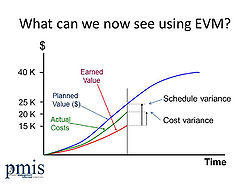Belbin's team roles
(→Belbin team roles) |
(→Belbin team roles) |
||
| Line 21: | Line 21: | ||
==Belbin team roles== | ==Belbin team roles== | ||
Belbin team roles consist of 9 different team roles <ref name=”article”> 2011 Michael Costello. Team weaver.</ref>. | Belbin team roles consist of 9 different team roles <ref name=”article”> 2011 Michael Costello. Team weaver.</ref>. | ||
| + | |||
| + | {| class="wikitable sortable" | ||
| + | |- | ||
| + | !Structure of the WBS | ||
| + | !Definition | ||
| + | |- | ||
| + | |'''Plant''' [[ | ||
| + | |The scope is defined as the broad strategy of the project which is planned. The scope is an important step of the process when developing the WBS since it determines a list of specific projects goals, objectives, main deliverables, tasks, cost and the deadline. | ||
| + | | | ||
| + | |-| | ||
| + | |'''Time''' | ||
| + | |An accurate time estimation is a skill essential for good project management. The time estimation drives the setting of the deadline for the deliverables and the planning process of the project. Furthermore, in this step a WBS dictionary is created. The WBS dictionary includes entries for each WBS component that briefly defines the scope or the statement of the work (SOW) which is a document that defines project- specific activities, deliverables and timelines. Furthermore, the SOW typically also includes detailed requirements and pricing. | ||
| + | | | ||
| + | |- | ||
| + | |'''Cost''' | ||
| + | |Cost is an essential part when planning a project. The cost within WBS involves budgeting and an integrated earned value management system (EVMS) also known as Earned value management (EVM). EVM is a project management technique for measuring the project performance and progress. EVM has the ability to combine measurements of the project management triangle which includes scope, time and costs. Furthermore, EVM is able to provide accurate forecasts of project performance problems. | ||
| + | |[[File:EVM-Status-chart.jpg|thumb|caption|Figure 2: ''An illustration of earned value management''|250px]] | ||
| + | |- | ||
| + | |'''Resources''' | ||
| + | |The last step of the WBS is identifying the resources within the project. The resources are determined by using the responsibility matrix. The responsibility matrix is used to define who in the organization is responsible for individual work elements and deliverables during the project period. The responsible matrix is divided into the following categories | ||
==How do I use Belbin team roles== | ==How do I use Belbin team roles== | ||
Revision as of 17:59, 8 February 2018
Abstract
To create the best team work, you need to know about how the different team workers behaves at their workspace and how to get the best out of the team members. The Belbin team roles can help you with identify the different team members strength and weaknesses. This can be used in all different kinds of projects and can help you create a team which have a high performance. Belbin's team roles test looks at how people behave in team work and which roles suits the different team members best. This article will help you understand why you should use Belbin team roles, how to use them and discuss the positive and negatives in using the method. This will be done by reading a lot of material such as Why use Belbin? [1]
Contents |
Dr. Meredith Belbin
Dr. Meredith Belbin has a doctor degree in psychology from Clare college in Cambridge. He has been an active management consultant in more than fifty years for many different international and private firms. He is a professor and researcher at Henley Business School in Oxfordshire, England. [2].
Dr. Meredith Belbin [3].
Dr. Meredith Belbin was born in 1926 [4] and is married to Eunice which is has a PhD focusing on the Psychology of ageing in industry.
Dr. Meredith Belbin originally identified the Team Roles as a part of a study of teams. This took place at Henley Business School. These study included a business simulation game. Dr. Meredith Belbin was invited in 1969 to use this business game as start if a study of team behavior. [5]
Dr. Meredith Belbin’s research gave to very important results. The first result showed it was possible to find and isolate nine different team roles, which could describe the inner psychological dynamic in a person as well as to describe the effects will have, partly on the employees and partly on the team. The second result was to make it possible to predict how well the team will preform from the different compositions of the nine team roles. [6]
Belbin team roles
Belbin team roles consist of 9 different team roles [7].
| Structure of the WBS | Definition | |
|---|---|---|
| Plant [[ | The scope is defined as the broad strategy of the project which is planned. The scope is an important step of the process when developing the WBS since it determines a list of specific projects goals, objectives, main deliverables, tasks, cost and the deadline. | |
| Time | An accurate time estimation is a skill essential for good project management. The time estimation drives the setting of the deadline for the deliverables and the planning process of the project. Furthermore, in this step a WBS dictionary is created. The WBS dictionary includes entries for each WBS component that briefly defines the scope or the statement of the work (SOW) which is a document that defines project- specific activities, deliverables and timelines. Furthermore, the SOW typically also includes detailed requirements and pricing. | |
| Cost | Cost is an essential part when planning a project. The cost within WBS involves budgeting and an integrated earned value management system (EVMS) also known as Earned value management (EVM). EVM is a project management technique for measuring the project performance and progress. EVM has the ability to combine measurements of the project management triangle which includes scope, time and costs. Furthermore, EVM is able to provide accurate forecasts of project performance problems. | |
| Resources | The last step of the WBS is identifying the resources within the project. The resources are determined by using the responsibility matrix. The responsibility matrix is used to define who in the organization is responsible for individual work elements and deliverables during the project period. The responsible matrix is divided into the following categories
How do I use Belbin team rolesLimitationsReferences
|

